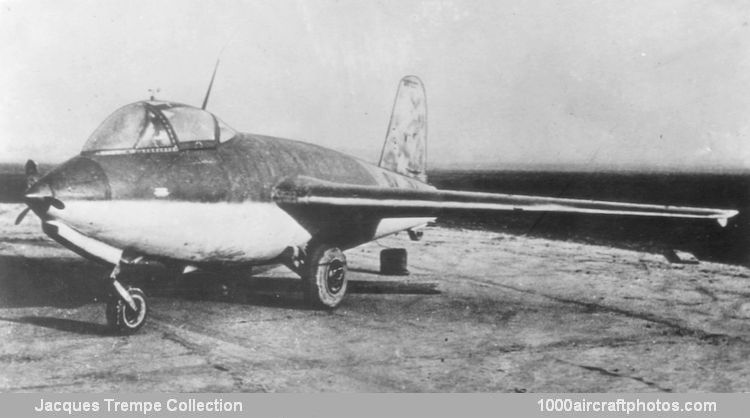10/31/2017. Remarks by Johan Visschedijk: "In the late summer of 1944, the Junkers-Werke was requested to develop a successor to the Messerschmitt Me 163 B under the cover name Flunder (Flounder) and to which the designation Ju 248 was assigned. While configurationally similar to the Me 163 B in having a modestly sweptback wing and lacking horizontal tail surfaces, the Junkers fighter was fundamentally a new design.
The combination of jettisonable take off dolly and landing skid featured by the Me 163 B was discarded in favor of a conventional retractable tricycle landing gear (which was tested by the Me 163 B V18), fuel capacity was increased and a Walter HWK 509C rocket motor was adopted. This bi-fuel power plant comprised a main chamber with a thrust of 4,409 lb (2,000 kg) and an auxiliary chamber providing a further 882 lb (400 kg). The wooden wings were essentially similar to those of the Me 163 B and the dural fuselage incorporated a pressure cabin, armament comprising two 1.18 in (30 mm) MK 108 cannon.
The Waggonfabrik Dessau built the jigs, mockup inspection took place on December 15, 1944 at Raguhn near Leipzig and in that month the designation of the fighter was changed by the RLM from Ju 248 to Me 263 despite the fact that all design and production responsibility remained invested in the Junkers organization. Meanwhile work began on three prototypes which, to accelerate the program, had Me 163 B wings modified and rebuilt by the Puklitsch company at Zeitz, and similar controls and instrumentation.
The OKL (Oberkommando der Luftwaffe, Air Force High Command) vacillated in its attitude towards the Me 263 née Ju 248. On January 13, 1945, the OKL report pressed strongly for the large-scale production of the new fighter, and, of two OKL reports dated January 29, one demanded termination of Me 263 development and the other replacement of the Me 163 B by the Me 263 in service with Jagdgeschwader 400 as rapidly as possible.
The attachment points of the HWK 509C rocket motors did not match the drawings, necessitating lengthening of the fuselages of the first two prototypes, the Me 263 V1 and V2, after construction. Initial flight testing began in March 1945, the power plant of the V1 being replaced by ballast, the landing gear being fixed in extended configuration and the aircraft being towed into the air for gliding trials. The V2 and V3 were also apparently tested in gliding flight, but there is no evidence of the HWK 509C having been lit in flight. One prototype was acquired by the Soviet Union and played a role in the development of the Mikoyan and Guerevich 1-270.
